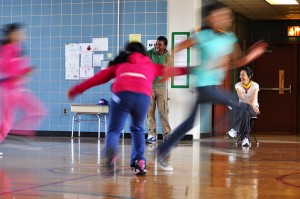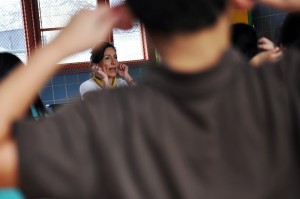Also read Fit Kids: Working Out with Parkour at a Brooklyn Charter, which explores parkour, a creative physical education alternative for city schools lacking sufficient gymnasium space to house a quality physical education program.
In the final moments of “flag tag” there is usually a heroic battle of two against one. Heightening the drama, the children on the sidelines chant the names of their surviving teammates. And when the last flag is taken the winners run to embrace each other like World Cup champions.
“I think it helps their brain regenerate,” said Elaine Gill, their physical education teacher. “So much is required of them. They need an outlet.”
Gill, the only physical education teacher at P.S. 24 in Sunset Park, Brooklyn, manages to teach about 500 of the school’s 750 students in once-a-week classes. It’s hardly enough time, but it’s all she can manage with the time and space she has. And even then, one-third of the school’s children do not have any gym at all.
New York State standards require that students in Kindergarten through third grade participate in physical education on a daily basis. Fourth through sixth graders are required to have gym at least three times per week.

Pushing physical education to the margins is a problem citywide, especially in elementary school where children are lucky to have physical education once a week.
This, despite widespread concerns over childhood obesity –it has more than doubled in the past 30 years, according to the Centers for Disease Control– and a growing body of scientific research linking physical education with health and academic benefits.
P.S. 24 has a decent-sized gymnasium. At about 3,200 square feet and the size of two classrooms, the children have room to run, though Gill notes that the space is not large enough to accommodate more than one class a time. “I couldn’t have them play a game like this if two classes were in here,” she said. “I couldn’t take them outside. There is a lack of space.”
Gill switched to physical education after 15 years as a classroom instructor, where she often taught kindergarten. She isn’t certified as a physical education teacher (which isn’t required at the elementary school level), but she is a fitness enthusiast, and is committed to helping prevent obesity in her students. Her classroom experience is something that certified teachers may lack, she said. “Which can be helpful in maintaining discipline.”
P.S. 24 is not the only school failing to meet state physical education standards. Thirty-one city elementary schools were audited by the City Comptroller’s office in 2011, and none of them were in compliance. The last audit by the State Comptroller in 2008 found 18 out of 20 school districts across the state out of compliance.
Maintaining pressure on the Department of Education, a report by the Women’s City Club of New York released this year showed that the city is not sufficiently staffed with teachers assigned to physical education at the elementary school level. Of those teachers assigned, only 53 percent are licensed in physical education, according to the data provided by the Independent Budget Office.
In comments to the media, Department of Education spokesperson Marge Feinberg called the Women’s City Club report “factually incorrect.”
Jeff Engel, assistant principal for health and physical education for Long Island City High School, spoke at an expert panel in April advocating for full implementation of physical education in the curriculum at city schools. “There has to be a financial will to do that,” he said in a phone interview. “You need money for teachers and for equipment, and there is just little to go around.”
Engel said that core academic classes are the natural priority for principals. This reflects Department of Education policies that hold them accountable for low standardized test scores but not for failing to provide quality physical education or for failing to fight childhood obesity.
But according to academic research, test scores may be improved through regular physical education classes.
In the first study of its kind to test a nationally representative sample size, researchers at Old Dominion University and Norfolk State University found regular physical education positively associated with academic achievement, better diet choices, and a positive self-concept in elementary school children. Results were published in “Health Education Journal” online in February.
The researchers used data from 10,120 fifth-graders, found in the Early Childhood Longitudinal Study provided by the National Center for Educational Statistics (NCES), and tested for body mas index (BMI), academic achievement, self-concept and social skills, taking into account diet and afterschool activities.
The NCES study evaluated academic achievement through standardized tests in reading, math and science. Researchers found a modest positive relationship between regular physical education and test scores.
Though more physical education in schools could be seen as a tool to combat childhood obesity, researchers were unable to link it with changes to the body mass index of the children studied.
They did find that children who spent more time in physical education consumed less sugary drinks and fast food calories. Children also demonstrated enhanced self-concepts, possibly resulting from improved self-esteem, according to the researchers.

At P.S. 24, the high stakes test culture in classrooms affects what Gill teaches in the gymnasium. After the excitement of flag tag she sits her students down in neat rows and runs through sets of test relaxation techniques and stretches they can perform sitting at their desks.
She has them practice thinking caps (gently pulling on the outer parts of the ears and slowly moving around the lobe), brain buttons (making an “L” with the thumb and index finger and pushing lightly with one hand below the collar bone and placing the other hand over the naval area), and energy yawns (massaging the muscles around the temporal mandibular joint at the junction of the jaws.)
Sitting in rows, the children are docile and attentive. Before, when they were engaged in play, Gill called out in soothing singsong to get their attention, “Stop… Look… And listen…“ On cue the 5th graders responded in unison while dropping to one knee, “Ok…”
The class ends with breathing exercises. Most participating, they raise their hands above their heads where they meet palm to palm and come down slowly as they exhale.
“You have to let them be active,” Gill said. “But then you have to get them ready for the next class.”


